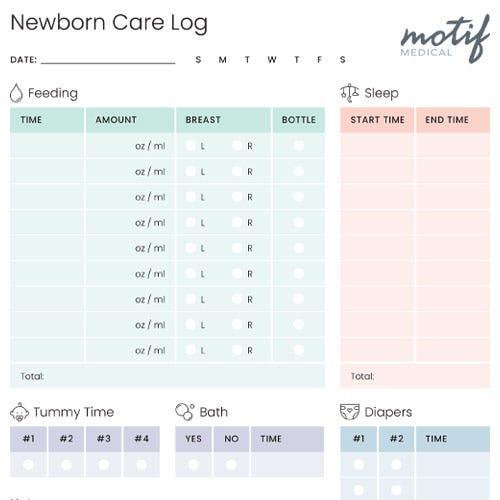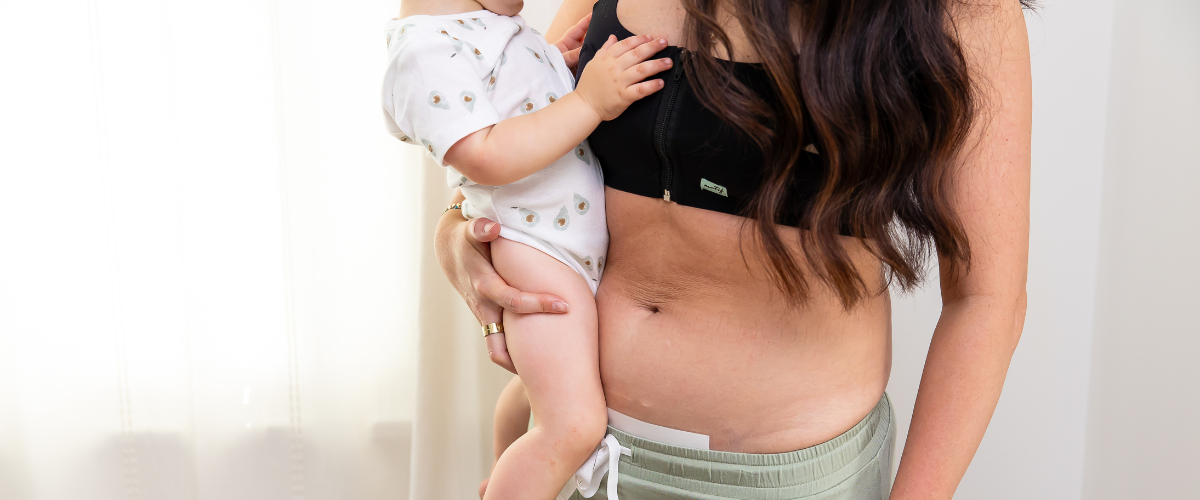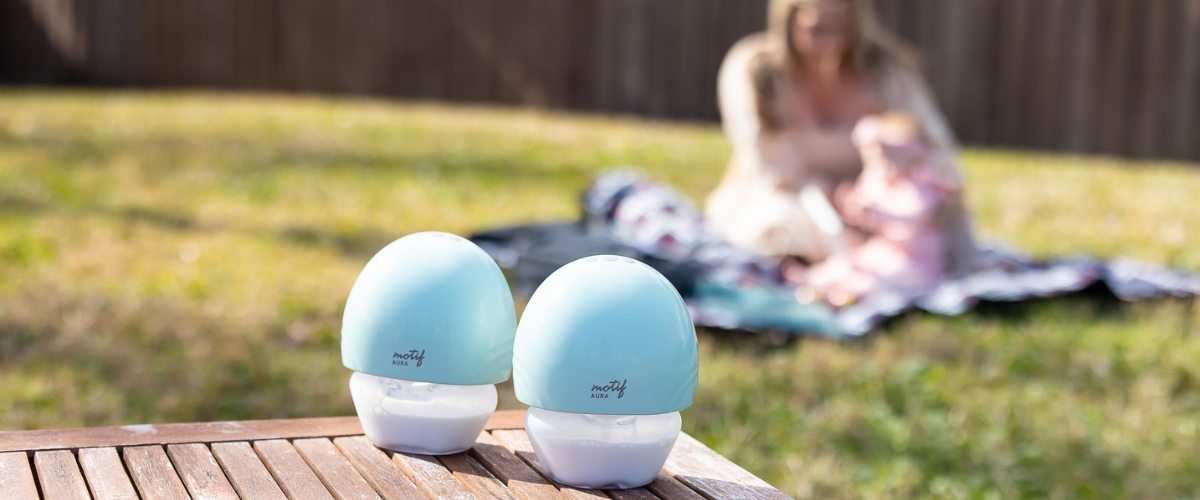Having a newborn baby in your home is fun, exciting...and exhausting! There are so many things to keep track of--their sleep schedule, diaper changes, feeding times and duration or amount...the list goes on! New parents have a full time job trying to figure out what their baby needs, so we've put together this printable schedule to try to make it easier for you to keep track of it all.
Feeding
Whether you're breastfeeding or bottle feeding, you're going to want to keep track of when your baby eats and how much they're eating. Breastfed babies tend to nurse a little more often than bottle fed babies eat because breast milk is digested faster, but either way, newborns should eat at least 8 times in a 24 hour period, or every 3-4 hours. It's not recommended to put your newborn on any kind of feeding schedule, particularly if you're breastfeeding since your baby's frequent feeds will help establish and increase your milk supply.
Just when you feel like you've gotten into a good feeding routine, your baby will have a growth spurt! These happen around 2 weeks, 8 weeks, 3 months, 6 months, and 9 months and you'll know your baby is in the middle of one when they suddenly start wanting to eat all the time--don't worry, this is a normal part of growth and development and your baby's feedings will spread back out once they're done with the growth spurt. As your baby gets bigger, they will go for longer stretches in-between feeds but if you're breastfeeding, it's also normal for your baby to keep nursing every 2 hours around the clock until you introduce table foods.
Use this chart to keep track of baby feeding by recording:
- Time baby ate
- If breastfeeding:
- On which side(s) baby breastfed
- How long they were latched on
- If bottle feeding:
- How many ounces they ate
- How many ounces you pumped


Sleep
From birth to about 2 months of age, a newborn baby will get about 15 hours of sleep in a day, occurring in 1 to 2 hours increments spread equally through day and night. A 2 month old baby will start sleeping for longer stretches and increasing their nighttime sleep. While getting up every couple of hours to take care of your baby is one of the hardest parts of newborn care, I don't recommend sleep training infants. Your little one is making a big transition into the outside world, and their sleep cycles are shorter and often the complete opposite of yours--It's totally normal for infant sleep patterns to have them awake and active at night and wanting to sleep more throughout the day.
A bedtime routine can be helpful to let your baby know that everyone is winding down for sleep and in general, your baby sleep schedule will flip to match yours within the first weeks of life. Until then, nap time will be your best friend. Having a white noise machine in your bedroom can make daytime sleep easier for new parents by drowning out surrounding sounds, particularly if you live in an apartment or townhouse. And as a reminder, when your newborn sleeps, make sure they are on their back on a firm surface. The American Academy of Pediatrics has reported a greater than 50% reduction in SIDS (Sudden Infant Death Syndrome) as a result of placing baby on their back to sleep.¹
Use this chart to keep track of your newborn sleep patterns by recording:
- Baby's night time sleep
- Baby naps during the day
- Use the notes to record:
- Sleep tips: anything that helped baby fall asleep (swaddling, singing, cuddles, etc)
- Anything that woke baby up
- If baby was fussing/gassy when trying to sleep
- When you slept--sometimes you can get so tired you forget to sleep!
Diapers
Your newborn baby should have 1 wet and 1 poopy diaper, per day old until your milk comes in or you begin giving your baby a bottle. Once your milk is in or they are getting regular bottles your baby will poop and pee frequently. New parents are usually changing their baby's diaper at least once with every feeding--and babies love to pee in a clean diaper so sometimes they'll do several diaper changes in one feeding! After day 3-4, your baby will pee at least 6 to 8 times a day. Unless you're cloth diapering, wet diapers can be hard to identify but you can use the color change diapers to help or some parents put a tissue in the diaper so they'll know if it was wet. Your baby should poop at least 2 times a day until they are 6 weeks old. After 6 weeks old, some babies will poop less frequently, as little as every 3 to 4 days. A baby's initial poop, called meconium, will be dark and very sticky, but as their stools transition, they will lighten and get easier to clean up.
Use this chart to keep track of diaper changes by recording:
- Wet diapers
- Poopy diapers
- Use the notes to keep track of:
- Changes in poop color/consistency
- Color of urine
Tummy time
You can start tummy time with your baby immediately after birth. Skin-to-skin gives new parents the perfect opportunity to lay with their baby on their tummy on the parent's chest. Only keep babies in this position for as long as they are comfortable, which may only be a couple minutes at a time. Even a few minutes a day will help them develop strength and coordination. By the time they are 3-4 months of age, they should be able to spend about 20 minutes on their tummy.
Use this chart to keep track of tummy time by recording:
- How long they spent on their tummy each day
Bath
According to the World Health Organization, an infant's first bath should be delayed for 24 hours after birth. This allows the baby to absorb any vernix and be able to self-regulate their temperature before they are bathed. After their initial bath, babies only need to be bathed about one a week. Bathing them too often can be harsh on their skin and lead to dry and peeling skin. Stick to natural, organic soaps without any fragrances or scents in them. If your baby needs something for dry skin, cradle cap, or eczema, the best thing to put on them is coconut oil.
Use this chart to keep track of baths by recording:
- Which day you gave a bath
- What products you used, in case baby develops a reaction to them
Hopefully this printable schedule will help you keep track of what your baby gets or needs throughout the day. As your little one settles into a sleep routine and daytime habits, I hope you're able to make the most of their wake times and long naps to bond and create a new normal for your family. If you have questions or concerns about your baby's intake, output, or weight gain, please contact your pediatrician or healthcare provider.
Sources
1. Moon, Rachel Y. and TASK FORCE ON SUDDEN INFANT DEATH SYNDROME. “SIDS and Other Sleep-Related Infant Deaths: Evidence Base for 2016 Updated Recommendations for a Safe Infant Sleeping Environment.” Pediatrics November 2016, 138 (5) e20162940; DOI: https://doi.org/10.1542/peds.2016-2940.
2. WHO recommendations on postnatal care of the mother and newborn. https://apps.who.int/iris/bitstream/handle/10665/97603/9789241506649_eng.pdf










